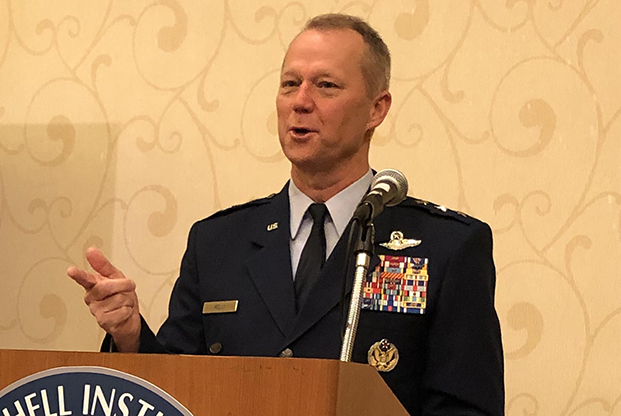
Air Force Lt. Gen. Mark Kelly, the service's deputy chief of staff for operations, delivers a keynote at a Dec. 5 event hosted by AFA's Mitchell Institute in Arlington, Va. Mitchell Institute photo.
The shift from near-peer to real-peer global military competition is forcing the US Air Force to rethink how it trains, deploys, and ultimately fights—and it will put extreme emphasis on the ability to maintain command, control, and situational awareness in a contested information environment, said Lt. Gen. Mark Kelly, USAF deputy chief of staff for operations, on Wednesday.
“The biggest growth area we have is in the information space,” he said at an AFA Mitchell Institute event in Arlington, Va. “The next [fight] is going to be the most congested and contested in terms of electromagnetic spectrum out there. …The team that will win is the one that can cut through that exponentiated chaos and get to decision-quality information.”
Competition with China and Russia demands the US rethink its traditional approaches to our rivals as they become more aggressive in operations short of war.
“In a western military campaign, we tend to shape the environment in Phase Zero, we deter in Phase 1, we seize the initiative in Phase 2, we dominate in Phase 3 combat operations, we stabilize in Phase 4, and we transition to civil authority in Phase 5,” Kelly said. “The US is really, really good in the deter and win categories. But competition below the threshold of major combat ops is primarily where our strategic peer adversaries are executing their national and military strategies.”
He cited China’s build-up of military bases and asserting national control of the China Sea and Russia’s action in Crimea as examples of asserting military power to gain territory “short of war, what some people might call gray zone competition.”
Countering such threats will require the US to be able to respond more quickly and less predictably. And should a conflict boil over from competition to direct conflict, the US military “must get out” of today’s single-domain, command and control models and evolve to where adversaries cannot exploit the seams between air, land, sea, space, and cyberspace C2.
“The modern fight will take place across all domains,” Kelly said. “It will traverse from one domain to another, literally, in a split second, and we have to make sure an air operations center can connect end to end to a naval operations center, which can connect end to end to a land operations center, and stop having stove-piped command and control.”
In a contested information environment, those C2 capabilities must also be resilient, so that if one node goes down, the overall system can automatically heal itself and continue operations.
“We have to assume every single leg of that C2 system will be challenged. Our adversaries know the level of dependency we have,” he added.